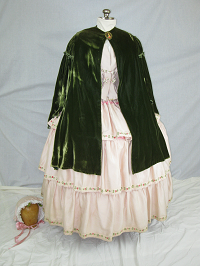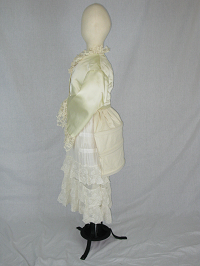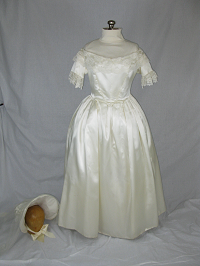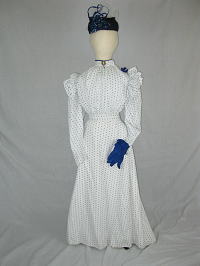
- Details
- Category: 19th century
- Hits: 2728
1850s and 1860s
The elegant styled green velvet mantle has ball trim to relieve the stiffness of its circular form. Still in vogue is the drop shoulder line which has been further emphasized by gathers and trim. A pin decorates the neck. A pink (maroon velvet) bonnet which sets back on the head covers the hair when out of doors. Inside the brim is blond lace with roses interspersed. The ruffle in the back is called a curtain. In the early Victorian era, the bonnet was considered the only correct form of head covering for the mature woman.
Pink hoop - 1856
In 1856, the legs were freed from the layers of petticoats by the re-invention of the hoop. While the hoop alleviated some problems, it caused crowding in rooms, and exposed the ankle. By 1858 one manufacturer was producing three to four thousand hoops every day. Cartoons ridiculed their size and street cars show them hanging on the outside. The invention of the sewing machine also had its effect on the women’s fashions, especially when it made its way into the home. This shortened the time spent on making an outfit, and American women used the time saved to add yards and yards of flounces and ruffles to the skirts. The weight of these skirts made the hoop a necessary evil, but also an elegant era for fashion.
The hoop supported the weight of this three-tiered skirt of pink antique satin trimmed in pink floral braid. Many dressed had both a day and evening body. This evening bodice is pointed front and back. The low neckline, edged in satin ribbon, has a fall of fine lace. Hooks and eyes close the back. The correctness of one’s attire was always under scrutiny. Every detail of the costume must be correct. Small hands were the symbol of gentility. Fingerless mitts were proper inside and were worn even when eating. Painted and decorative gloves were given to wedding guests as favors. The hair, covered most of the time, is uncovered and adorned with flowers when dressed for a ball or wedding.
The chatelaines worn throughout the previous centuries continued to be used but with different necessities. When dressed in the tight corsets, a vinaigrette with smelling salts was needed in case you had a “fit of the vapors.” Also a touch up of perfume might be appropriate.
Click photo for detailed view.
- Details
- Category: 19th century
- Hits: 2792
1876
This antique white Po de Sue satin gown of 1876 would be appropriate for a wedding. The upper skirt is edged in lace and buttoned over a trained underskirt which was worn over a bustle and a tiered petticoat.
Even if the gown was originally white, a woman could be practical. The material was chosen so it could be dyed progressively darker colors. Magazine articles also had hints on how to remodel the gowns to keep in fashion. Many antique gowns are discovered to be made of material from an earlier period. The veil, used by brides from the early 1800s, is also off white, with medallions of lace carefully sewn to it. The hair is arranged in four rows of curls across the top of the head interspersed with flowers and a tortoise shell comb. One superstition was to wait until the bride was ready before taking the last stitch on the gown. Her bouquet, called a “tussie mussie” (which means a cluster or knot), contains roses for love, mint for virtue, and lavender for luck. The warmth of the hands caused the herbs to give off a pleasant odor. Shoes are leather and have been trimmed with satin and lace puffs.
Click photo for detailed view.
- Details
- Category: 19th century
- Hits: 2520
1840s
In the 1840s the favorite colors were plum, gold, olive. Two gowns in the Cincinnati Museum of Art were used to recreate this new gown in off white satin. At this time, women would play the part of lovely porcelain dolls as an escape from the harshness of reality. Clothing fashioners went to extremes in creating this demure and fragile look. All things feminine, delicacy, smallness, frailty, beauty were sought after, and fashion was the vehicle for achievement. Writers talked about an inner light but along with the religious fervor came coquettish behavior. The large brimmed bonnets were said to be used to hide from the stray glances of a beau or to flirt, whichever a young lady wished. Veils, in use from early in the century, now hang from the brim or crown of the bonnet to be drawn over the face or tied under the chin.
The bodice is always lined and boned. A number of these bodices were found to have pads of wool attached in front to supplement the deficiencies of anatomy, a device specially in use the first half of the 1840s before the “artificial bust improver” was invented. It was the fashion to be willowy, and young ladies assiduously practiced slimming so they might be able to display an 18-inch waist. They also began to use dress protectors of india rubber or chamois leather, sewn into the dress. The skirt, except for summer, was lined either with silesia (a twill cotton lining fabric) or for eveningwear with the same thin cotton muslin used for book covers at the time. Winter dresses were frequently lined with flannel between the cotton and the dress material. In this dress, the skirt is of three-and-a-half yards of fabric, tightly pleated in the back.
Underneath the dress were several layers, which gave a bouffant airy appearance. Watches were worn on long chains, and many women’s outfits included a small watch pockets placed in waistline.
Click photo for detailed view.
- Details
- Category: 19th century
- Hits: 2507
1893
This gown was copied from Harper’s Bazaar, 1893, in white faille, trimmed in a crossover of rosepoint lace. The high stand-up neck band is hooked at the side. Neckbands were boned to hold the chin high. The bodice is pointed in both front and back. The word corsage changed from a bodice to a bouquet of flowers. A corsage of silk roses is pinned to the shoulder and forms the head piece for a full length tulle veil. The huge sleeves returned in 1893. Skirt fullness all in the back. Many wedding gowns of this time were in color, such as plum, robin’s egg blue. The wedding gown would be worn by the bride as the dinner or evening dress for the next year.
Click photo for detailed view.
- Details
- Category: 19th century
- Hits: 2682
1890s
This white cotton two piece outfit was suitable for a young girl’s graduation or Confirmation. The skirt is lined with polished cotton and has four and a half yards of cording along the bottom edge. The bodice, also lined, has large sleeves and double ruffles to add width across the shoulders. The high collar is edged with blue piping to match the ribbon rosettes at neck and waist. A belt covers the juncture of the bodice and skirt of this summer costume.
The leg-of-mutton sleeve returned from 1893 to 1897. Caps were no longer needed to cover a woman’s head indoors, but no lady went outside without her hat and gloves. The hat of straw is decorated with net, ribbon and artificial grapes. High feathers or ribbon added height to the small hats popular during this time.
As material was only 27 to 36 inches wide, these gowns required 12 to 14 yards of both the outer and lining material. Fabric cost as little as 10 cents a yard for cheap cotton calico up to $10 a yard for a silk or wool brocade. Daily wages for a seamstress amounted to 30 to 50 cents. The middle and upper classes had their dresses tailor-made. The lower class bought their things ready-made from department stores, or sewed them themselves using patterns from one of the companies such as Butterick.
Click photo for detailed view.
Page 6 of 13





